I was asked to sit in again on MobileCupOfJoe‘s What’s Brewing? show. We talked about OnePlus, CyanogenMod, the Sony hack and more. Enjoy.
LG Tone Bluetooth headset comparison
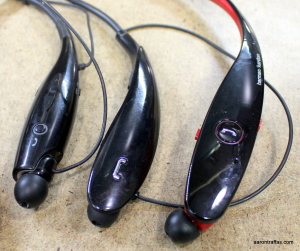
I spend the majority of the waking hours of each day with a podcast playing in my ear. While I’m farming, I use two headsets for different purposes. I use the Motorola S10-HD when I’m working on or under equipment because it doesn’t fall off my head. The rest of the time, I use an LG Tone+. I’ve found the Tone+ to be light and amazingly comfortable, as well as very easy to quickly insert and remove from just one ear while wearing it. Wearing comfortably with just one ear is crucial for me, as I need to hear the equipment I’m operating with the other ear, so the Tone is superior to alternatives like the S10-HD and the BlueAnt Pump because they really can’t be worn comfortably in just one ear.
I bought my Tone+ in the summer of 2013, and it lasted through that season, through the winter and through the 2014 season. For someone who is as tough on devices as I am, that lifespan is a demonstration of very impressive durability, especially considering that the headset was in use for an average of 12 hours each day. I’d turn it on at 6 a.m. when I left the house and run it until the battery ran down, which was usually about 12 hours later.
As my Tone+, model HBS730, began to age, I began wondering if some of the other models of the LG Tone series might prove superior to my Tone Pro. I ordered a Tone Ultra, model HBS800, a couple months ago. Then, recently, Verizon asked me if I’d be interested in testing the LG Tone Infinim, the HBS-900. What follows is a comparison of these three headsets, the HBS730, HBS800 and HBS-900, with a focus on usability.
Common features
Each headset features a play-pause button on the right and a call button and charging port on the left. They all have equalizer preset modes, allowing selection among normal, bass boost and treble boost modes. While I haven’t tested the Ultra and Infinim for months on end like the Tone+, I’ve found no problems with battery life, with each model seeming to do at least better than 10 hours for constant audio playback.
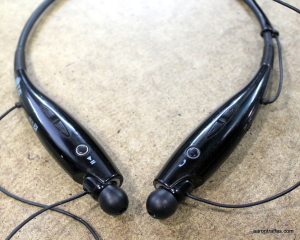
LG Tone+ HBS730
Near and dear to my heart, the Tone+ has proven itself over the last year-and-a-half. The volume rocker is on the superior, or top, left and the tract selection rocker switch is on the superior right. The power switch is on the left, but, unlike the Ultra and Infinim, it’s on the distal side, facing away from the neck instead of the proximal, or inside, side of the headset. I’m not sure why later devices moved the power switch to the proximal side, but the Tone+ definitely has the best placement of the power switch.
The sound quality is adequate. The default EQ mode was always good enough for me, as I don’t demand pristine audio quality, especially for podcasts. When I do focus on sound quality, I find the sound of the Tone+ to be the worst of the three units compared here. It’s slightly muddy in each of the three modes, with no real way to shape the mid-range response to my liking. Having said that, for anyone but the most discerning audiophile, the sound from the HBS730 is certainly good enough.

LG Tone Ultra HBS800
Where the Tone+ was essentially flat in shape, the Tone Ultra has a pronounced curve to it, obviously in hopes that it fits more comfortably about the neck. I never had a problem with the comfort of the Tone+, so this shape change seems like a solution in search of a problem. However, I can’t complain about the comfort of the Ultra. What I can complain about is usability.
The Ultra is unquestionably the hardest of these three models to use. The buttons are simply harder to get to and harder to use. The power switch has been moved to the proximal side. The volume and track selection rocker switches have been moved from the superior to the distal sides of the left and right sides, respectively. These rocker switches are much more difficult to get to and, where I could easily operate the rockers with gloves on the Tone+, the Ultra requires a fair mount of fine motor skills just to adjust the volume or track. Additionally, the call and play-pause buttons, instead of being round, are shaped like icons. I’m not sure if it’s the change in shape of the buttons or the change in shape of the magnetic earbud holders that leave them more open on the dorsal side, but these buttons are difficult to use compared to the Tone+ unless I’m holding my thumb on the back side to use as counter-pressure.
The sound quality of the Tone Ultra is branded as JBL, and while it’s noticeably better than the Tone+, it’s not good enough to offset the nosedive in usability and additional cost of the Ultra over the Tone+.
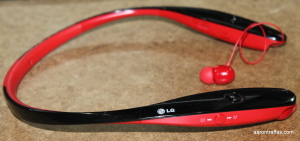
LG Tone Infinim HBS-900
The Tone Infinim has some significant differences from its predecessors. The Tone+ and the Ultra have thin, flexible neck bands, while the Infinim is a a thicker and harder plastic with a flexing region of just a couple inches in the very back. The added weight adds a premium feel.
The next most significant difference is the change to the earbud cords. The Tone+ and Ultra feature fixed length cord that emerge mid-way up the neck and are held in place at the left and right ends with magnets. The Infinim has much thinner cords which actually retract into the headset, so when they’re fully retracted there is no cord showing. While it’s convenient when charging or transporting it to have the cords retracted, I’ve found that, because the cords emerge at the ends of the left and right sides instead of mid-way up the neck like the Tone+ and Ultra, it actually results in a longer cord that’s exposed when in use. This additional cable length is inconvenient when I pull the earbud out of my ear temporarily as it is just more cord to catch on clothing or other obstacles. As I’ve been caring for my two-month-old son for the last few weeks, it’s certainly less convenient than the Tone+ or Ultra to have the longer cable dangling for him to grab and try to eat when I’m holding him. It’s also more arduous to have to operate the retraction mechanism than it is to simply return an earbud to its magnetic holder with the other two models.
The buttons are also different. The play-pause and call buttons are round, but, unlike the Tone+, they’re recessed. I can see them being harder to use with gloves than the Tone+. Also, instead of rocker switches for volume and track selection, the Infinim uses sliders. While the sliders are more usable than the rockers on the Ultra, they’re still more cumbersome than the controls on the Tone+.
The sound quality of the Infinim is the best of the three models. It’s branded as harman/kardon and is a noticeable improvement in clarity from the other two models. The highs are clearer on all three preset modes and the mix feels balanced and much less muddy.
Selecting the right LG Tone headset for you
Each headset handles Bluetooth multipoint, which, as an example, allows it to pair with a phone and a tablet simultaneously. I use this feature on my Tone+ extensively in the tractor cab. They also feature other gimmicks, such as voice actions and the ability of the Infinim to read back the time. At the end of the day, I’m looking for a quality headset with excellent usability and acceptable sound quality at the lowest price.
The version of the Infinim Verizon sent me is red and black, while the only color scheme listed on LG’s website is silver. The lack of a black version is a deal-breaker for me, as is the price tag, which is, at the time I’m writing this review, about $150. If I had only a desk job, the controls on the Infinim, as well as the unique retractable earbuds, would be fine. I’m afraid that I just wouldn’t be happy with the Infinim for my use on the farm. However, if you want the best sound possible, don’t have an industrial application and don’t mind the red or silver color schemes, you can’t go wrong with the LG Tone Infinim.
What would I buy? I just bought a bucket of Tone+ headsets – one as a backup and the rest as stocking stuffers for family. At a fraction of the cost of the Infinim, and with much better usability than the Ultra, the Tone+ is an amazing value for a dependable, durable headset with good sound and amazing battery life.
2014 Sharon Christmas parade
We had a ton of fun yesterday in Sharon. Thanks to Diane for taking the pictures while I was occupied.
What’s Brewing for November 14
I had a great time guesting on the What’s Brewing podcast from Mobile Cup of Joe. We talked about phones and tech news. Enjoy.
The LG G3 is still the best Verizon phone for the farm
This is the story of my personal journey to find the best phone on the market for use on the farm. Hint – it’s the LG G3. Here’s how I got there.
I started this year with a Samsung Galaxy Note 3 that I bought after my Samsung Galaxy Nexus – the previously best phone on Verizon – stopped working in the fall of 2013. While many others didn’t like the Verizon variant of the Galaxy Nexus, I had no problems with it. When it died, the Note 3 had the best specs of any phone at the time so that’s what I bought.
It was horrible. The first thing I noticed was the software. The Samsung Galaxy Note 3, compared to the Galaxy Nexus, was loaded with TouchWiz. TouchWiz is Samsung’s overlay on top of Android designed to make it unlike any other brand of phone – harder to use, uglier to look at and loaded with enough additional features that it’s hard to find them all to turn them off. Compare to the Nexus, there were so many useless carrier apps preinstalled that I learned of an entire community dedicated to the removal of this hard-to-remove bloatware. To make matters worse, very shortly after I bought my Note 3, Verizon started offering a developer edition that would have saved me most of the headaches around software. As it was, I spent days figuring out how to get a custom ROM on my device that resembled the Android I know and love.
The second and more severe problem I had with the Note 3 is one the developer edition wouldn’t have helped me with. While I was traveling for Purple Wave and even at my house, I had pretty good mobile service. However, last May as I started working weekends on the farm, it became clear that the reception on my Note 3 was substantially poorer than that of my Galaxy Nexus. I reviewed the HTC One M8 for Verizon in April, and commented that the reception seemed a little better than my Note 3, and even my Galaxy Nexus, but hadn’t spent enough time on the farm to know just how badly the Note 3 performed.
At first I didn’t know it was Samsung’s fault. I spent harvest barely able to check email in several of my fields. I ordered a replacement Note 3, believing that I might have caused a problem with the software hacking I had done to get rid of the awful TouchWiz experience and all the red apps that came preinstalled. The replacement, with the stock experience, performed exactly as poorly as my Note 3 had. Indeed, as I started paying closer attention, it seemed that the Galaxy S3s that my mother and wife had at the time, as well as the Galaxy S4 that my sister still has, all suffered from a significant problem – Samsung’s current phones simply have poor antennas.
It was so bad that I considered leaving Verizon, wondering if it was some kind of deleterious change in Verizon’s network similar to the bad experience we had in a reduction in quality of the Sprint network in 2012. I decided to assess my options. I wanted to know if it was Verizon’s fault or Samsung’s fault. I ordered a Google Nexus 5 and got an account with Cricket. I also bought a Moto X from eBay to see if it performed differently on Verizon than my Note 3.
I learned that the Google Nexus 5 is an amazing phone. It still boggles my mind that Verizon hasn’t carried the Nexus series after the Galaxy Nexus – it would have made the Android experience so much better for its customers. Unfortunately, Cricket – which piggybacks on the AT&T network – doesn’t seem to have solid coverage on my farm. It was even worse than the Note 3 experience with Verizon. I let my Cricket account expire after the first month, but I kept the Nexus 5 to use around the house, even without the ability to make phone calls, because it’s just that good of a device.
I received the Moto X and immediately noticed a difference. First, the software experience was clean and, unlike Samsung, made me excited to use Android again. Second, the reception was amazing. In the fields where the Samsung phones could barely check email, the Moto X was streaming HBO Go and Netflix to my tablet in my cab without buffering. I was relieved to learn that the problem was Samsung and not Verizon, so I could stay with Verizon and not give up my unlimited data plan.
It was about this point in time that I received the Kyocera Brigadier to review. A rugged phone, I tested it for a couple weeks of fieldwork. It’s antenna performance wasn’t quite as good as the Moto X, but it was substantially better than the Samsung phones’.
I was left with a somewhat significant problem, though, with the Moto X. After using the Note 3, the Moto X has a tiny screen and a tiny battery. The non-removable back meant that the battery wasn’t upgradable, like that of my Note 3, and there weren’t any battery cases on the market. I found myself at the Iowa State Fair in August and, afterwards, spoke with a nice guy at the Verizon booth at the fair who spoke candidly with me about antenna performance in phones, and he promised me that the G3 was easy to root and would get reception nearly as good as the Moto X. I gave my Moto X to my wife and ordered a G3 from eBay.
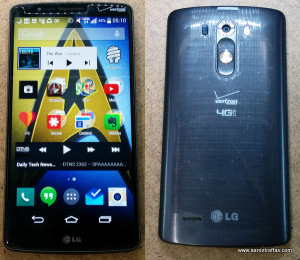
The LG G3 is slightly smaller than the Note 3, but it’s still a big phone. At 5.5 inches, the quad HD IPS display is gorgeous. The processor was the fastest in any major phone at the time, and the camera is a 13 MP sensor with optical image stabilization and laser focus. To this day, it’s one of the best cameras in a phone on the market, taking fast and reliably accurate pictures. LG made a interesting design choice by putting the power and volume buttons in the center of the back rather than around the edges like most manufacturers. I quickly got used to the button locations, but also to the double-tap to wake feature that lets me wake the phone by tapping the screen.
The G3 hasn’t actually been easy to root as I was promised, until recently, and we’re only just now seeing the ability to install custom version of Android. This means I’ve been stuck with the factory interface. The software on the G3 has been customized by LG, but unlike Samsung, I don’t want to murder LG’s design team. They’ve got a consistent design aesthetic that doesn’t seem to interfere with Android’s functions, and the carrier bloat has been easy to disable or freeze with Titanium Backup.

What makes the LG G3 the best phone for the farm, however, isn’t its speed or its camera. It’s the fact that it has a removable battery. The stock battery life is fine if you’re at a desk and don’t mind charging it throughout the day, but when I’m farming I want a phone on my belt that provides a consistent hotspot for my tablets and streams podcasts to my Bluetooth headset from 6 a.m. until after 10 p.m. – without having to charge it. The Zerolemon 9000 mAh battery for the LG G3 makes it the perfect phone for the farm – or any industrial use where charging is inconvenient and all-day battery life is a must.
While I’ve had the G3, I’ve reviewed the new Moto X and the Droid Turbo. They’re both great phones, but neither has an upgradable battery. The Turbo’s battery is big, but it’s still less than 4000 mAh, which is simply insufficient for a day on the farm. Even after the launch of the Nexus 6, the G3 will remain the only phone with good reception, acceptable software and an upgradable battery on the Verizon network.
I’m now in the process of getting the rest of my family away from all Samsung devices. I’m giving my G3 to my wife as soon as my Motorola Nexus 6 arrives – I want to keep the G3 close in case there isn’t a big battery case for the Nexus 6 by next summer. Mom is getting my wife’s Moto X and my sister is upgrading to the Droid Turbo. We’ll be rid of Samsung just as soon as I punt my Galaxy Gear Live in favor of the Zenwatch.
Here’s a picture gallery – unaltered – from the wonderful camera on the LG G3. Enjoy.
- On the hill
- Dirty farmer’s helper
- Poor man’s cover crop
- Low light before sunrise
- But Dad!
- Feeding the fish
- Drilling wheat
- Canola coming up
- Soil texture close-up
Moto X review
The Moto X is the smartest of smartphones currently available. It’s got decent hardware and a software experience that is as good as you’ll find today on Verizon. Check out my full review at AuctioneerTech.
BlueAnt Pump HD Bluetooth headset

Key to maintaining sanity on the farm is a continual stream of podcasts and, occasionally, music. I spend all day every day with gadgets in my ears, and Verizon let me recently spend a few weeks with a BlueAnt Pump HD headset to see how it held up.
The BlueAnt Pump HD is rugged and resistant to sweat and water. It features large earpieces that sit over and behind each ear, somewhat like large, stylish hearing aids, connected by a cord. There are three control buttons, located on the right earpiece, that handle all music and call functions.
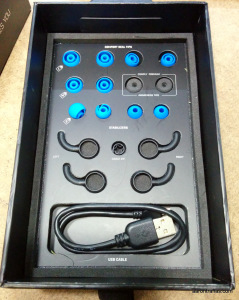
The headset comes with a selection of ear pieces comprising large, medium and small plastic “comfort seal” tips, as well as a set of Comply premium awareness foam tips. Also included in the box are stabilizers and a cable tie to tweak the fit of the headset about the head.
The headset is quite comfortable and, unlike other designs, I never had to worry about it falling off, even without the stabilizers. I usually wear the LG Tone+, and any time I get on a creeper or crawl under a piece of machinery it will fall off. The nature of the design of the Pump, however, makes it pretty much impossible to wear only one ear, which is frequently how I use the Tone+. It’s also very uncomfortable with glasses, making it less desirable than the Tone+ when I’m driving.
The controls are very simple to use. Three buttons are fewer than the control sets on the other headsets I’ve used, but all functions are present with only the three buttons and it’s nice to not have to remember which ear to find the volume rocker or the forward and back control. Everything is behind the right ear on the Pump.
I found that I would get about five or six hours of battery life with the Pump, which was somewhat disappointing to me. I use a headset about 12 hours a day, which means I’d need another option to get me through the rest of the day. If, however, you’re looking for something to use for a workout, or something to wear while servicing equipment, the Pump is would be a very nice option from a battery life perspective.
Finally, let’s talk about sound quality. As a musician, I’m a big audiophile. My preference is for crisp vocals, clear highs and a low end that is proportional to the balance of the rest of the sound. I used the plastic tips, as pictured, for the majority of my review. I found the sound quality to be fairly muddy, with a weak bass response and a high end that easily got lost. I got quickly used to it for podcasts, but it wasn’t a very good experience when listening to music.

Before wrapping up my trial, I swapped the tips with a set of Comply foam tips and was stunned at the difference in fit and sound. The Comply tips are isolation tips, both blocking out external sound as well as completely changing the sound entering the ear canal. The weak bass response in music I experienced with the plastic tips was replaced by a brain bumping low end that drowned out the rest of the sound. Now, I’m very critical of the modern trend towards bass-heavy music, and I would guess that the frequency response of the Pump is similar to that of other new and popular headsets on the market. I used the equalizer in Google Play Music to adjust the sound to a nature to which I would would enjoy listening and I’ve attached a screenshot.
If you’re a fan of a bass heavy sound, or you don’t mind making some tweaks to the equalizer, the Pump has an overwhelming punch and volume to spare when used with the Comply earpieces. With a behind-the-ear design, it’s a comfortable option for a workout or when working in awkward positions.
Callan Traffas
Callan Traffas was born last night shortly after 8 p.m. at Pratt Regional Medical Center in Pratt, Kan. Both he and Diane are doing quite well today.
Unlike his brother Nolan, Callan did not arrive by cesarean. He weighed 7 pounds and 11 ounces and was 20 inches long.
I guess I got a couple days’ break from drilling wheat. Enjoy the pictures.
- The new Traffas family
- Pre game apple pie
- Watching Orphan Black in the waiting room
- Callan’s first picture
- Aunt Erica and Callan
- Grandma Marilyn and Callan
- Brothers
- Nolan and Callan

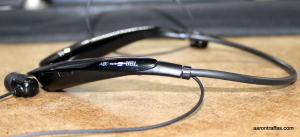
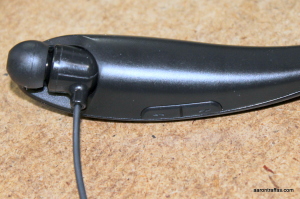






























































You must be logged in to post a comment.